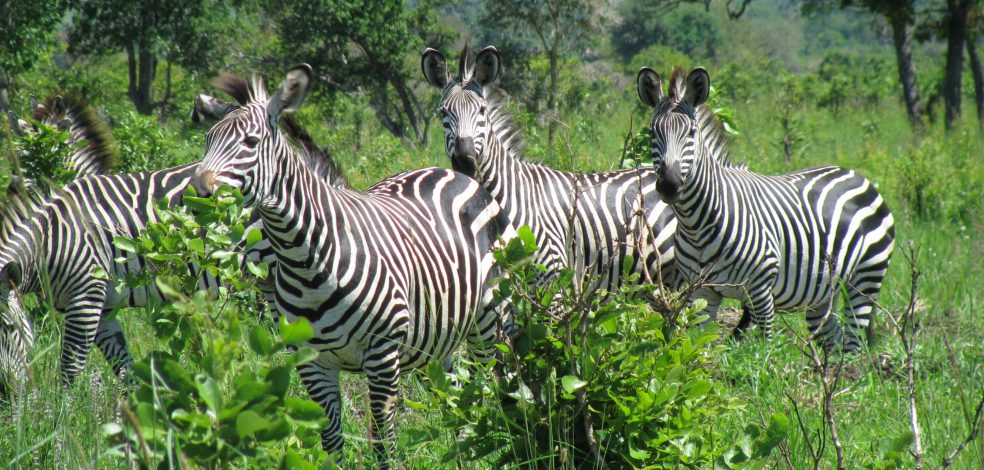Biological diversity is one part of “ecosystem structure”. Other components of ecosystem structure include which species are present, how abundant they are, whether some species are particularly important for the ecosystem to function, and how all the species interact with each other and the environment. So ecosystem structure is a pretty loaded concept, and figuring out what controls ecosystem structure has captured the intellect and imagination of many ecologists for a long time.
Two mutually non-exclusive theories have emerged in discussion of control of ecosystem structure. The bottom-up control hypothesis argues that the producers (primarily plants) are key, so factors influencing plants (such as sun, water and soils), are paramount for understanding ecosystem structure. The top-down control hypothesis argues that carnivores eat herbivores and herbivores eat plants, so we should focus our attention on the carnivores who directly influence herbivore abundance, and indirectly (by virtue of their effects on herbivores) influence plant abundance and diversity.
Rong Wang, his research advisor Xiao-Yong Chen, and several other researchers recognized that Thousand Island Lake would be a perfect place to explore these hypotheses about control of ecosystem structure. Construction of the Xin’an River Dam in 1959 created the lake of 573 km2 that is dotted with more than 1000 islands of varying size. This creates a natural laboratory for ecologists interested in understanding how island size influences ecosystem structure and specifically to explore the relative importance of bottom-up vs. top-down effects. In addition, these islands are actually forest fragments surrounded by a matrix that is inhospitable to terrestrial species. Ecologists are very interested in how fragmentation influences ecosystem structure, because development projects (residential, commercial, public works, etc.) invariably produce fragments of habitat of varying size. Lastly, when establishing nature preserves or conservancies, conservation ecologists need to know how large their reserves should be in order to optimize biological diversity and ecosystem functioning.

The major producer in this ecosystem is the evergreen tree, Castanopsis sclerophylla.

Their seeds are eaten by two species of rodents, which in turn are eaten by carnivores – primarily snakes, cats and weasels. The researchers knew about these interactions before beginning the study, but they wanted to understand precisely how each player affected ecosystem structure, and how the size of the ecosystem influenced these different levels. They also wanted to explore possible bottom-up effects; for example how does environmental quality affect ecosystem structure.

For their study, Wang and his colleagues established research sites on habitats of three different size classes: four small islands (0.6 – 3.2 ha), three medium islands (13-51 ha) and six large habitats (three on the only large island of 875 ha and three on the mainland forest). Initially the researchers conducted surveys of Castanopsis sclerophylla seedling density, rodent density and environmental conditions. They discovered that seedlings were much more abundant on the mainland and large island (graph a below), while rodents were much more abundant on medium islands (graph b). However, small islands were more subject to drought due to lower soil moisture content and higher temperatures – a result of greater surface area exposed to the sun along the perimeter of each small island (graph c and d). Ecologists call this the edge effect. If you refer back to the first photo in this blog, you will note that the small island in the foreground has a great deal of exposed edge.

Over several years, the researchers systematically placed 12,500 seeds of Castanopsis sclerophylla on the surface across all of the sites, and tracked seed predation and seed dispersal. Seeds on medium islands survived much more poorly than did seeds on the other habitats (top graph below). Wang and his colleagues also planted 2,750 seeds of Castanopsis sclerophylla in transects across all four sites. In this case seedling emergence and survival was much lower on small islands than any of the other three habitats (bottom graph).

Piecing together these data, we can see both top-down and bottom-up forces influencing ecosystem structure depending on the size of the habitat. On the mainland and on large islands there are several different types of predators which feed on rodents. But medium and small islands are just too small to support viable populations of predators. Thus rodents are super-abundant on medium islands, and eat the seeds that are on the surface. This is an example of top-down effects causing a trophic cascade, with predators eating rodents, which leads to high seed survival on large habitats. However on medium islands, predators are absent causing rodents to increase sharply and consume most of the seeds.
But bottom-up effects prevail on small islands, which are so small that that they support only a few rodents. Seeds that are broadcast on the surface survive predation from the small rodent population relatively well, but seeds that are planted have poor survival because of low soil moisture and high temperature (the edge effect). I asked Chen whether he thought we could generalize that top-down effects might be more important on large scales and bottom-up effects on small scales. He responded that both types of regulation are likely to be scale-dependent in many different ecosystems, but that species composition and resource availability would determine how top-down vs. bottom-up control ultimately influences ecosystem structure.
note: the paper that describes this research is from the journal Ecology. The reference is Wang, R., Zhang, X., Shi, Y.‐S., Li, Y.‐Y., Wu, J., He, F., and Chen, X.‐Y.. 2020. Habitat fragmentation changes top‐down and bottom‐up controls of food webs. Ecology 101( 8):e03062. 10.1002/ecy.3062. Thanks to the Ecological Society of America for allowing me to use figures from the paper. Copyright © 2020 by the Ecological Society of America. All rights reserved.
